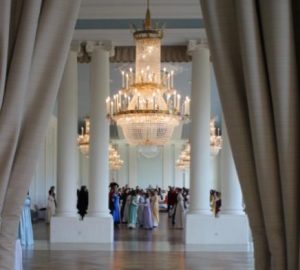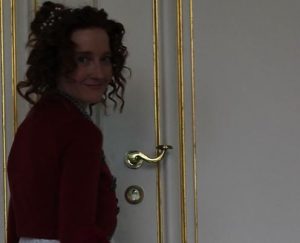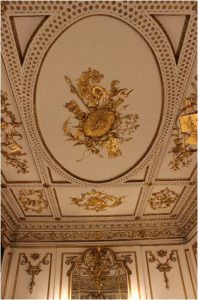 May I have the pleasure of this Waltz? It is the most controversial dance of the Regency Period. That the Waltz was considered scandalous certainly isn’t new to you. But there were more reasons than too much intimacy between the dance partners that made people turn up their noses at the Waltz. Among the despisers was e.g. Lord Byron who can hardly be counted among the moralisers of the age. So what was wrong with the Waltz? Continue reading
May I have the pleasure of this Waltz? It is the most controversial dance of the Regency Period. That the Waltz was considered scandalous certainly isn’t new to you. But there were more reasons than too much intimacy between the dance partners that made people turn up their noses at the Waltz. Among the despisers was e.g. Lord Byron who can hardly be counted among the moralisers of the age. So what was wrong with the Waltz? Continue reading
Results for Tag: Dance
Sign your name across my card
How to use a dance card in the Romantic Age

For a young lady few things would be more satisfying than being a sought-after dancing partner at a glamourous ball. But if she was in constant demand, how would she keep track of the partners engaging her for the waltz or the cotillion later in the evening? And how would a gentleman secure a dance with her?
Keeping track of the gentlemen who had promised a dance in the course of the evening was done – on the Continent – with the assistance of a so called ‘carnet de bal‘ (a dance card). A gentleman would ask a lady to write down his name on the card a for a specific dance. These small and often precious carnets de bal were very popular in France and Austria throughout the 18th century.
In Britain, the dance card became fashionable at around the turn of the 18th century. The carnet de bal initially was often less elaborate than the Continental model.
A Jane Austen Ball in Pictures
 Dancing at a historical ball in a perfect Regency period-setting: my dream of heaven came true a couple of days ago at the Grand Jane Austen Ball in Ansbach/Germany.
Dancing at a historical ball in a perfect Regency period-setting: my dream of heaven came true a couple of days ago at the Grand Jane Austen Ball in Ansbach/Germany.
I have selected some photos of the event for you. Follow me to a splendid night in ‘Regency-Wonderland’. Continue reading
A Time Traveller’s Adventure: At the Opening of Norfolk House
Let’s leave the Romantic Age for one glamorous evening and go to the mid 18th century. We shall discover one of the major society events of the year 1756: The opening of Norfolk House in London.
Follow me to ‘All Things Georgian’, the brilliant website of Sarah Murden and Joanne Major, history detectives and acclaimed authoresses. Sarah and Joanne kindly feature my guest post about a grand event and 6 tips to succeed there as time travelling guests of the Duke and Duchess of Norfolk.
Please click here to go to the post and find out more.
Best regards,
Anna M. Thane
Anna and the Mystery of the Triple Minor (part 2) – Free Music Download of “Lady Caroline Lee’s Waltz”
In this post:
- Dance instructions for “Lady Caroline Lee’s Waltz” for you to perform and enjoy
- Free music download: “Lady Caroline Lee’s Waltz” (mp3)
- Free music sheet for “Lady Caroline Lee’s Waltz”
Dear Regency Enthusiast
as promised, here is my post with dance instructions and a free mp3 soundfile for “Lady Caroline Lee’s Waltz”.
Lady Caroline Leigh was a distant relative of Jane Austen. Her son James Henry was a second cousin to Jane. It is easy to imagine that the “Lady Caroline Lee’s Waltz” was danced as part of the evening entertainment when Jane visited James Henry. The music sheet for the “Lady Caroline Lee’s Waltz” was part of Jane Austen’s library. It is, however, still the status quo of the Austen-research to have solely proven she danced the boulangère, and I don’t want to imply anything else.
Dance instructions for “Lady Caroline Lee’s Waltz” for you to perform and enjoy Continue reading
Anna and the Mystery of the Triple Minor (Part 1)
In this post:
The truth about longway dances of Jane Austen’s time
How to perform a longway dance in a historically correct way
Tips for depicting a ball in your novel
Preview: Dance instruction and music to come in part 2
Dear Regency Enthusiast
A couple of weeks ago I took part in a workshop in Old English Country Dances*. First-hand experience of the culture and techniques of the regency era can be very enlightening for writers (see my post on Five Methods of Research). Indeed I came across very helpful facts – and a dark secret of contemporary country dance teaching. Fancy that: All the longway dances from Jane Austen’s time are today deliberately taught historically incorrect. Shocking! Why are the dances usually done incorrectly? How were they really performed? And what should you know to when you write a scene with a ball for your novel? Continue reading

